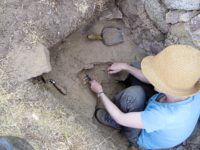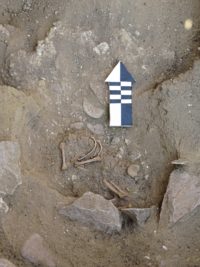 The skeletal remains of an infant unearthed at a Roman fort in Guernsey have been found to date to the early 19th century. Archaeologists were excavating the gatehouse, cutting into the top of it and confirming that later overbuilding had destroyed much of the original Roman floor, when they unearthed the skull of a infant in a shallow grave.
The skeletal remains of an infant unearthed at a Roman fort in Guernsey have been found to date to the early 19th century. Archaeologists were excavating the gatehouse, cutting into the top of it and confirming that later overbuilding had destroyed much of the original Roman floor, when they unearthed the skull of a infant in a shallow grave.
Once the police had visited the site and given permission, the grave was carefully excavated by archaeologist Jenny Cataroche, who specialises in the study of human bones.
Ms Cataroche said that, while it was not possible to determine whether it was a boy or a girl, the bones were consistent with a gestational age of 38 to 40 weeks, meaning it was a baby carried to full term.
‘There were no grave goods or clothing remnants found with the skeleton so it is most likely the baby was wrapped in a blanket or shawl, of which nothing remains,’ she said. ‘It was placed on its right side with knees drawn up to the chest and hands near the face.
‘The unusual location of the burial – not in a churchyard – suggests that the baby was unbaptised, perhaps stillborn. We are probably looking at death linked to complications of pregnancy or birth which, sadly, would have been much more common in the past.’
 They knew the infant didn’t date to the Roman period because the grave was in the part of the gatehouse that had been reconstructed in 1793 so it had to been buried after that. Samples of the bone were sent to a specialist laboratory in Florida for radiocarbon dating. The date returned was 1820, minus or plus 30 years, during a time when the fort, known as the Nunnery, was a British military barracks and hospital.
They knew the infant didn’t date to the Roman period because the grave was in the part of the gatehouse that had been reconstructed in 1793 so it had to been buried after that. Samples of the bone were sent to a specialist laboratory in Florida for radiocarbon dating. The date returned was 1820, minus or plus 30 years, during a time when the fort, known as the Nunnery, was a British military barracks and hospital.
The fort was built on the island of Alderney overlooking Longis Bay, the island’s only natural harbour in the 4th century A.D. Alderney is only eight miles from the tip of the Cherbourg Peninsula of Normandy and France is clearly visible from the island. The Channel Islands were on a busy trade route between northwestern Gaul and southern Britain and Longis Bay was well-placed for a Roman naval outpost to keep an eye on that route. The harbour was large enough to allow at least a couple of warships to be based there for a quick response to any pirates.
Alderney’s strategic importance would be recognized after the Romans left by authorities and pirates alike. On the headland just above the Nunnery are the remains of Essex Castle, built by Henry VIII in 1546 over the remains of what is believed to have been a 9th century promontory fort. Queen Mary stopped construction and the castle was converted into the residence of the Governors of Alderney.
Without intact fortifications, the island became a base for pirates, with only the local militia of no more than 200 men defending it. The British interest in Alderney as a military outpost revived with the French Revolution. Soldiers were sent and artillery were sent there in the late 18th century and gun batteries and barracks built. By the end of the Napoleonic Wars, there were 20 batteries, almost 100 cannon, 600 regular soldiers almost 400 militia men.
The Nunnery was built up into a defensive fort in the 1840s. France expanded Cherbourg harbour in 1842, and in response Britain embarked on a program of breakwater and harbour construction and heavy fortification in the Channel Islands. The project was abandoned in the 1860s, but a new enemy, Nazi Germany, was glad to take advantage of the forts, when it occupied Channels in 1940. Alderney was almost entirely evacuated when the Germans arrived. They used the Nunnery as a site for anti-aircraft batteries, anti-tank walls, bunkers. After the war it was used by the British military, and then as private holiday homes.
Island lore had it that the Nunnery had once been a Roman fort, but nobody really knew what the buildings were and when they were built. It got its colloquial name because of this confusion; people called it the Nunnery because it sort of looked like a medieval monastery. Excavations in 2009 and 2010 found the first architectural evidence that the Nunnery was a Roman fort.
Dr Jason Monaghan, Guernsey Museums director, said: “In 2009 we proved there was a Roman building inside the Nunnery and began to suspect this was a tower as all the northern English forts have a tower in the middle.
“In 2010 we went back specifically looking to prove there was a tower there – and ‘wow’ is there a tower.
“The walls are 2.8m (9ft) thick, we don’t know how high it was, but it would have been a very big structure – it’s as thick as Hadrian’s Wall.”
The tower was found to be about 18 sq m. (58 sq ft).
He said the team dug down to prove the outside walls were also Roman before doing the same for the gateway.
So much of the fort walls were found that the Alderley Nunnery turns out to be best-preserved Roman small fort in Britain.
So sad. I often think about the lives behind these finds. May that infant Rest In Peace.